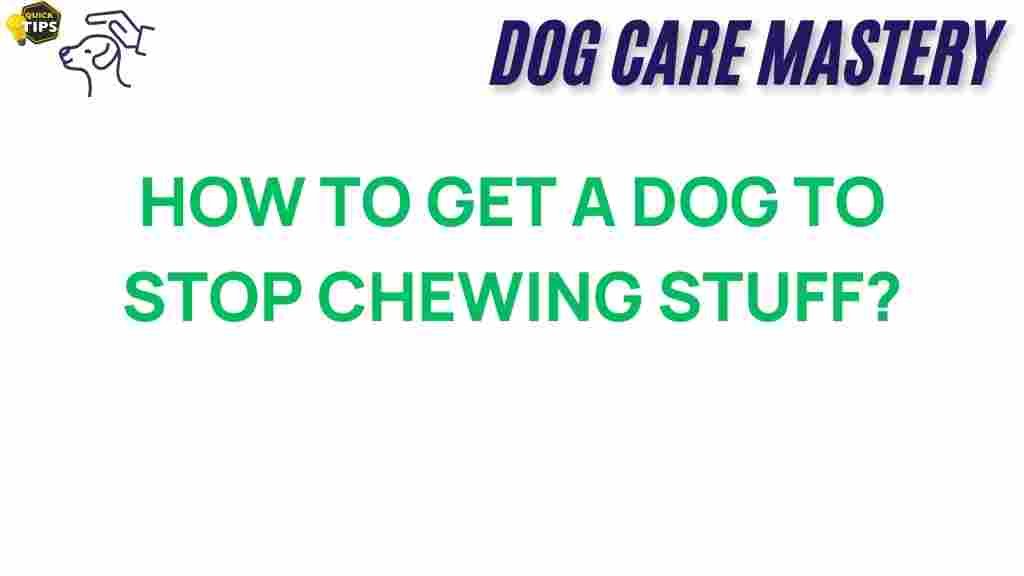Unraveling the Mystery: How to Stop Your Dog from Chewing Everything
Dog chewing is a common behavior that can be both frustrating and confusing for pet owners. Whether your furry friend is targeting your shoes, furniture, or even the remote control, understanding the reasons behind this behavior is crucial for finding effective solutions. In this article, we will explore the causes of dog chewing, provide practical tips to curb this behavior, and offer troubleshooting advice for persistent chewers.
Understanding Dog Chewing: Why It Happens
Before diving into solutions, it’s essential to understand why your dog might be chewing everything in sight. Here are some common reasons:
- Teething: Just like human babies, puppies go through a teething phase that can lead to excessive chewing to relieve discomfort.
- Boredom: Dogs are active creatures that require physical and mental stimulation. Lack of exercise or engagement can lead to destructive behaviors, including chewing.
- Anxiety: Dogs may chew to cope with anxiety, whether it’s separation anxiety or fear of loud noises.
- Exploration: Dogs use their mouths to explore the world, and puppies, in particular, are prone to chewing as a way to learn about their environment.
- Attention-Seeking: Sometimes, dogs chew things they’re not supposed to in an attempt to get their owner’s attention.
Step-by-Step Process to Stop Dog Chewing
Now that we’ve covered the reasons behind dog chewing, let’s explore a step-by-step process to help you manage and reduce this behavior effectively.
1. Provide Appropriate Chewing Outlets
One of the best ways to prevent dog chewing is to offer appropriate alternatives. Investing in chew toys can redirect your dog’s natural urge to chew. Consider the following types:
- Rubber toys: Durable and often come in various shapes and sizes, making them perfect for aggressive chewers.
- Rawhide bones: These can satisfy chewing instincts but should be given in moderation and under supervision.
- Interactive toys: Toys that dispense treats can keep your dog engaged for longer periods, reducing boredom-related chewing.
2. Increase Exercise and Playtime
Incorporating more physical activity into your dog’s routine can significantly reduce destructive chewing. Here’s how:
- Daily walks: Aim for at least 30 minutes of walking each day, adjusted based on your dog’s breed and energy levels.
- Play sessions: Engage in games like fetch or tug-of-war to burn off excess energy.
- Dog parks: Allow your dog to socialize and play with other dogs, which can also provide mental stimulation.
3. Implement Training Techniques
Training is a critical component in managing dog chewing. Here are some effective techniques:
- Positive reinforcement: Reward your dog with treats or praise when they chew on appropriate items.
- Redirecting behavior: When you catch your dog chewing something they shouldn’t, calmly redirect them to an appropriate chew toy.
- Command training: Teach your dog commands like “leave it” or “no” to help them understand boundaries.
4. Use Deterrents
If your dog is particularly stubborn, using deterrents can help. Here are some options:
- Bitter sprays: These are non-toxic sprays that can be applied to furniture and other items to deter chewing.
- Covering items: Use baby gates or furniture covers to protect items you don’t want chewed.
- Crate training: When you are not home, consider crate training your dog to prevent them from having access to items they might chew.
Troubleshooting Common Dog Chewing Issues
Even after implementing these strategies, some dogs may continue to chew excessively. Here are some troubleshooting tips to consider:
Identifying Triggers
Observe your dog closely to identify any specific triggers that lead to chewing. Keeping a journal can help you track when and where the chewing occurs, allowing you to address the root causes effectively.
Consult a Professional
If you’ve tried various methods without success, it may be time to consult a professional dog trainer or a veterinarian. They can provide tailored advice based on your dog’s specific needs and behaviors.
Consider Health Issues
In some cases, excessive chewing may be a sign of underlying health problems. If your dog is chewing more than usual, consult with a veterinarian to rule out any medical issues.
Conclusion
Dog chewing can be a perplexing issue, but with patience and consistent training, you can help your furry friend learn appropriate chewing behaviors. Remember to provide suitable alternatives, increase exercise, and implement effective training techniques. If chewing persists, don’t hesitate to seek professional advice. By understanding the motivations behind dog chewing, you can create a harmonious environment for both you and your pet.
For more information on pet training and behavior, you can check out this helpful resource.
Also, if you are looking for more tips on pet care, visit our blog for a variety of articles tailored for pet owners.
This article is in the category Behavior and created by dogcaremastery Team
